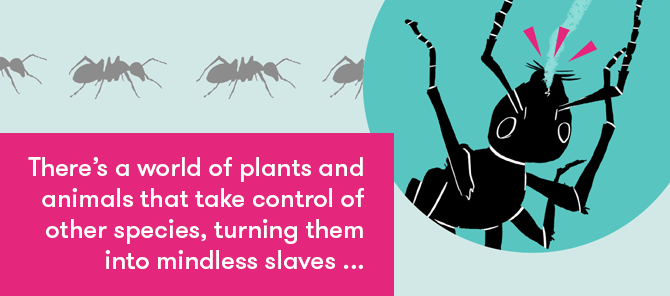Zombies!
Expert reviewers
Essentials
- The study of zombies has real-world implications for infectious disease modelling and public health planning.
- Real-world ‘zombification’ can be the result of chemical changes in the nervous system or the deterioration of the brain. This occurs in a number of species, including humans.
- There are no known diseases or afflictions that allow for continuous reanimation of corpses.
- If a zombie outbreak were to occur, the outlook wouldn’t look good for humanity … but if we quickly took wisely-planned and coordinated action, we might be able to survive.
We are living through a zombie epidemic. Movies, TV shows, books, games, events … zombies are everywhere. But it’s not all fiction: from tiny creatures that lose their minds to diseases that change us, ‘zombies’ exist in the real world.
What do real zombies look like? How zombie-like are they, really? And if an outbreak happened, would we be doomed?
The zombie condition
Let’s start by taking a moment to consider what we’re talking about. The meaning of ‘zombie’ has morphed over the ages, having associations with slavery, voodoo, reincarnation, ghosts and ghouls, plague, apathy, radiation, infection. Zombies can be dead but reanimated, alive but controlled, or supernatural. In modern zombie fiction they tend to be the reanimated type, yet there is still huge variety—slow zombies, running zombies, exploding zombies, spitting and frothing zombies, zombies with weapons, or zombie limbs without bodies. They may retain some semblance of their memory, personality or intelligence, or none at all. Not all of them are driven to eat human brains GLOSSARY brainsBRAAAAAIIINNNS (though most crave human flesh), they don’t all pass on their disease by biting (sometimes it’s by airborne viruses or disease-carrying insects) and not all of them were once human (zombie dogs are another manifestation).
Jason Thompson, an artist and zombie fan, has catalogued more than 350 different types of zombies in a massive taxonomy map.
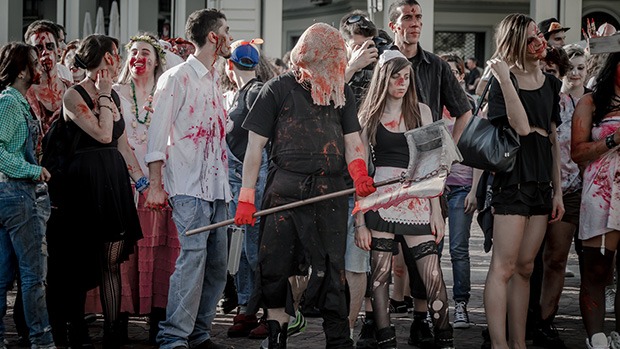
There are no solid rules about what makes a zombie. Image source: Ivan Crivellaro / Flickr.
This variety is indicative of the power of the zombie as a storytelling tool: no matter what the fears of our time or the preferences of the author, a zombie story can be crafted to evoke an emotional response.
In taking a stab (or, perhaps, a head-chopping swing) at three key elements of the modern zombie, the first recurring theme is the loss of identity and self-control, often replaced with aggression or basic urges. Next, there’s the risk of contagion—whether by biting, breathing, spitting or poisoning. Finally, there’s reanimation—death is not the end of these horrors. Let’s see whether real-world zombies have these elements.
The zombies among us
Parasitic puppeteers
Our first stop in the tour of real-world zombies begins beneath our feet … but not necessarily in the grave. We’re talking about zombie ants.
With tiny brains and tiny immune systems, small animals tend to be easier targets for parasites that force their victims to lose control. But don’t get too comfortable … more complex animals, including humans, aren’t immune from parasitic mind control, because the underlying mechanism that leads to this parasitic puppeteering is part of us all.
As an ant forages for food, it might ingest some spores of a parasitic fungus, Ophiocordyceps unilateralis. The ant soon starts a drunken walk, and then—in actions unusual for unaffected ants—it climbs away from its fellow ants (or is later carried away) up a tree or a blade of grass and chomps down to stay in place. The fungus kills the ant from the inside, sprouts out of its head and releases spores onto the ground below, to start all over again.
It’s tempting to think that the fungus has complete control over the ant during these bouts of infection. But part of the behaviour of infected ants may be an evolutionary adaptation—an attempt to save their friends from infection. Even so, the fungus does cause the ant to lose some self-control, leading to the clenching of jaws that root it in place for the fungus party to begin.
How does this happen? Chemicals! Specifically, chemicals that interact with the ant’s nervous system (which includes its brain). We all have nervous systems with chemical receptors, so all a parasite needs to do to control us is create the right chemical cocktail and get it inside our bodies. This is harder for bigger and more complex creatures—but evolution is relentless, and it certainly doesn’t stop at zombie ants.
Further up in complexity we turn to worms that hijack crickets. ‘Gordian worms’ live inside the cosy body of a cricket for months. Then, persuaded by these worms, the crickets seek water and dive in—a dangerous activity for the cricket, who is essentially leaving its habitat behind. The worms burrow out and lay their eggs. When the eggs hatch, they sometimes move on to an intermediate host—insects like mosquitoes that eat the larvae, until they’re eaten, in turn, by a cricket … and so it goes on. Like the ant, the mechanism that the worm uses to control its host is the creation of chemicals that affect the cricket’s central nervous system.
There are many more examples of insects that lose their minds, but what about more complex animals?
Toxoplasma
If you’ve ever owned a cat or been in contact with undercooked meat, you may be carrying a parasite called Toxoplasma gondii. If you do, you’re not alone—roughly a third of all people are thought to carry it. This parasite can cause an infection known as toxoplasmosis, which is generally thought to cause only mild effects in most people. But if you’re pregnant, the infection may cause complications (including potential damage to the unborn baby’s nervous system). Some evidence also suggests that adult humans with the parasite may have personality changes such as increased recklessness, which may lead to a higher chance of death.
The extent of the human personality shifts caused by toxoplasmosis is still being investigated, but we do know that the infection can be disastrous for mice. Infected mice and rats lose their fear of cats, and so are more likely to be eaten. Why? The toxoplasma parasite can only reproduce within cat guts, so it’s evolved the ability to affect the brain—and behaviour—of its hosts.
The fact that the single-celled toxoplasma can change mammalian minds suggests that we may be more susceptible to personality changes by parasites than we might think. It’s not impossible to imagine parasites that could lead us towards aggression, maybe decrease our aversion to cannibalism or, at the very least, give us a slower gait and a duller gaze.
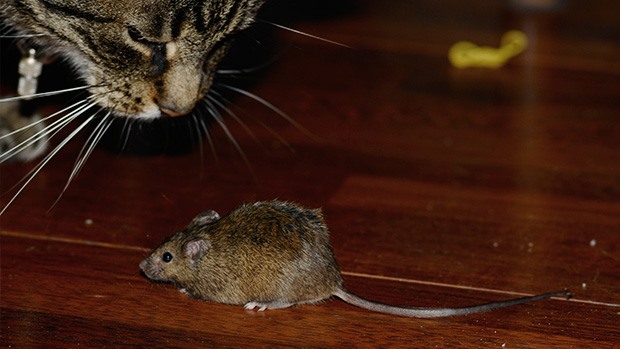
The toxoplasma parasite makes rodents lose their fear of cats, and some evidence suggests it may cause personality changes in humans. Image source: Floris van Halm / Flickr.
Prion diseases
Moving on to diseases with more noticeable human symptoms, how about coordination problems, tremors and shaking limbs? The symptoms of kuru—an incurable disease found in tribal regions of Papua New Guinea—may sound like those suffered by zombies, but it’s kind of a reverse zombie disease. Human cannibalism leads to its onset, rather than the disease causing cannibalism. (So if you’re living through an apocalypse, think twice before you resort to eating your fellow survivors … it might just make a zombie of you.)
Kuru is worth mentioning within the context of zombies not only because of its links to cannibalism and its zombie-like symptoms, but because it was the first prion disease GLOSSARY prion diseaseAlso called ‘transmissible spongiform encephalopathies’, these diseases cause the brain to become spongy (hence ‘spongiform’). known to occur in our species. Among other prion diseases is the better-known variant Creutzfeldt-Jakob disease GLOSSARY variant Creutzfeldt-Jakob diseaseThe human version of mad cow disease (vCJD) that causes the brain to rapidly degenerate. Dementia, memory loss, personality changes, psychosis, jerky movements, difficulty walking, involuntary movements … these symptoms are frightening and a little zombie-like.
Prion diseases work by affecting the nervous system (are you noticing a trend?). Prions themselves are little misshapen proteins that tell other proteins to become misshapen, like irresistible origami instructions that are shared through the body. Sometimes it takes decades for symptoms of these diseases to show up but, eventually, they manifest into catastrophic, so-far incurable conditions. And you don’t need to eat another human to get a prion disease—they can be transmitted by eating diseased meat, receiving contaminated blood, or by the use of unsterilised medical equipment. Prion diseases are rare nowadays but, with a drop in human hygiene (perhaps due to an apocalypse), they may rise again …
Rabies
In looking for potential real-world aggressive zombies, we come to the ‘rage virus’ that some claim is the virus that inspired the modern zombie genre. Rabies affects mammals such as cats, dogs, cows, and humans.
Rabies works by infecting—you guessed it—the nervous system. Violence, inability to move parts of the body, confusion, loss of consciousness—these symptoms closely mirror modern incarnations of zombies. But, like kuru and vCJD, the result of rabies is death. It’s an unsustainable strategy for global zombie domination. Even so, perhaps rabies could one day mutate into something else. If it spread more rapidly or led to a slower death (or no death at all), we’d be looking at something pretty close to a zombie disease.
Are they really zombies?
While the examples above meet the ‘loss of control’ condition of zombification (though not exactly to the point of cannibalism), most have ‘contagion’, and some have ‘aggression’, it’s arguable that none of these examples are really zombie-like. They’re all missing that final component: reanimation from death. The zombie ant may go on temporarily as an undead vessel for its fungus puppet masters, but it will never walk again. The mice that are changed by toxoplasma may forever have lost part of their former selves, but they’re still alive (until they get eaten by their new feline pals). And when human sufferers of kuru or rabies succumb to the virus, they’re not coming back from the grave.
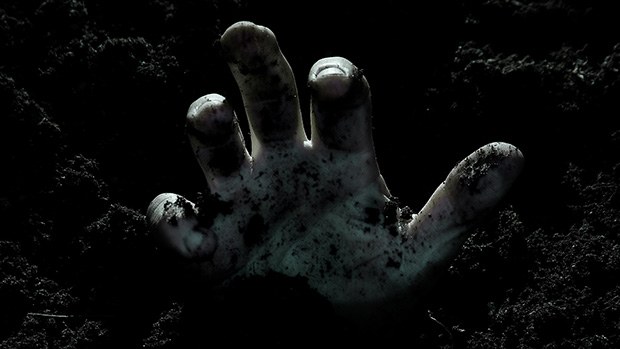
A frightening element of many fictional zombies is that they keep coming back after death. Image source: Jo Christian Oterhals / Flickr.
What’s the reality of reanimation?
Medical advances have extended our lives and altered our definition of death: resuscitation, defibrillation, surgery, the awakening of those in comas … we keep getting better at coming back. But these medical interventions are not contagious. And, while near-death trauma can change us, no one revived after their heart has stopped has returned as a full-on zombie.
The bottom line is that we’ve not seen a real, true, zombie disease out there in the real world. There are still horrific diseases and parasites and other afflictions, but none that lead to potentially continuous cycles of undeath after death.
But we’re not done talking about zombies yet! Diseases can surprise us—so let’s imagine that, one day in the future, there’s a new contagious disease. It somehow hijacks live and dead nervous systems to turn humans and corpses into stumbling, drunken, convulsing beings, and it uses chemical cocktails to modify our behaviour towards aggression and cannibalism. It’s a real zombie outbreak.
Who would win?
Humans vs zombies: modelling the spread of infection
In a paper titled ‘When zombies attack! Mathematical modelling of an outbreak of zombie infection’, a group of mathematicians introduced the basic model of how a zombie infection might spread. It’s similar to other basic models of infectious diseases. With this type of modelling we can use maths—together with our knowledge of zombies—to work out the outcome of a zombie apocalypse, and figure out what we need to do to survive. Let’s do it.

Zombies aren’t so good at thinking and planning, but humans are—so we should use that to our advantage. Image source: Nathan Rupert / Flickr.
The mathematicians began by interpreting the zombie scenario to include these three states of being:
Susceptible (S)
humans who can be turned into zombies
Zombie (Z)
zombies
Removed (R)
humans or zombies that have been removed from the normal population by death, but may return as a future zombie
We can illustrate the relationships between these states as a flowchart, with arrows that represent possible movements from state to state (such as S → R, which is the conversion of a human into a zombie; or R → Z, which is the conversion of a corpse into an active zombie).

If we want to use this model to analyse the outlook of humanity, we need to know how often the movements between these states occur, and how many zombies and susceptible people we start off with. The researchers also made a few more assumptions: that zombies do not defeat each other, and no other kinds of creatures (like zombie dogs) are involved in the spread of the disease. Plug everything in, and we get …
Okay, so that’s not reassuring … but it’s not over yet. With a latent infection time (that is, infected humans will carry the disease for some period of time before becoming a zombie) plus quarantine (infected humans and zombies can be isolated to contain the outbreak) we get the following …

It may take longer for them to succeed, but we’re still doomed. But what if we can produce a cure? If we found a way to turn zombies back into the susceptible (replacing the need for quarantine) …

Survival! But not a very good one. The authors of the basic model for zombie infection concluded that ‘a zombie outbreak is likely to lead to the collapse of civilisation, unless it is dealt with quickly’.
You may have realised that some factors are not listed in the models above. This is a common procedure of modelling—you start with basic knowledge of the situation, then add more information as it becomes available. So mathematicians from around the world built on the basic model of zombies in a book called ‘Mathematical Modelling of Zombies’, edited by one of the authors of the original article—Robert Smith?—a Canadian-based Australian mathematician whose name legally contains a question mark.
Delving into the details of these models help to show which factors really matter in our survival, and which can be ignored.
What about a vaccine—something that makes us immune from infection in the first place? We would have to act fast—the destruction of humanity can happen in a matter of days without one. Vaccination might change an epidemic disease to an endemic one (where infection rates remain more-or-less constant, rather than increasing over time).
Do you disagree with the outcomes from these models? Is there something missing? Luckily for us, we’re not dealing with a real zombie outbreak—but this means our ability to model the situation is limited. We have no evidence of what kind of zombies these are and what the state of the world will be. When public health experts model the spread of real diseases, they input data from our knowledge as it improves over time, rather than relying solely on their assumptions.
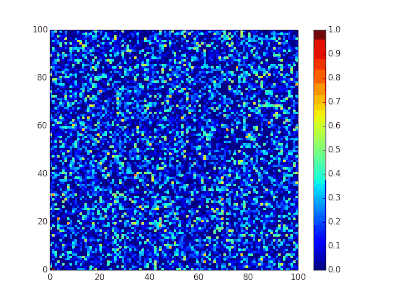
The SIR (susceptible, infectious, recovered) model is used for simulating the spread almost all infectious diseases. In the case of the above animation, each dot of colour in the 100x100 grid represents a person and the colour represents their state (susceptible blue, infected green, and recovered red). Here, each infected person can spread the disease to the eight people around them—and the final result is that the disease is spread to every person represented on the grid. With different details in the model, the simulation would play out differently.
Image source: Andrew Luo / Wikimedia Commons.
One thing remains clear from models of zombies and other undead: there’s often a huge difference in outcome when the right actions are taken to prevent the spread of the disease. The more informed and timely our actions, the better our chances of survival. That’s why public health planning and response is critical—not just for those at ground zero, but for everyone across the world.
So although we’ve yet to see a ‘true’ zombie disease, the zombie phenomenon gives us a safe way to explore death, disease, public health and the potential collapse of civilisation. We can investigate what scares us, think about how we would plan disease prevention and control strategies in an ethical way, and, on a personal level, hone our survival skills.
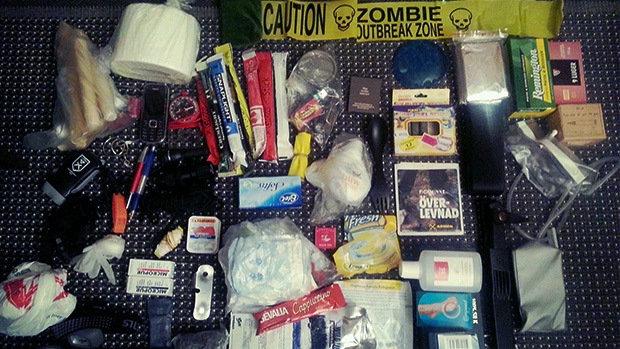
What would you put in your survival kit for the zombie apocalypse? Image source: Theleom / Flickr.






